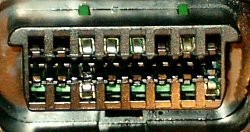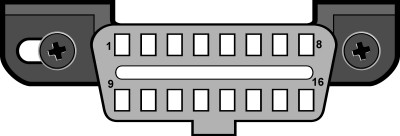Navigating the world of vehicle diagnostics can be complex, especially when it comes to understanding OBD-II compliance. It’s crucial to know if your vehicle adheres to these standards, as it directly impacts your ability to use modern diagnostic tools and understand your car’s health. This guide will clarify what OBD-II compliance means, how to determine if your vehicle is compliant, and why it matters for vehicle owners and technicians alike.
Determining OBD-II Compliance: It’s Based on Where Your Vehicle Was First Sold
A common misconception is that OBD-II compliance is determined by where a vehicle was manufactured. However, the standard is actually based on the country where the vehicle was originally sold as new. This distinction is vital when figuring out if your car is OBD-II compliant.
To easily check your vehicle’s compatibility, refer to the chart below. Find the country where your vehicle was initially sold to determine the model year requirements for OBD-II compliance. If your country isn’t listed, consult your vehicle’s owner manual, search online resources, or contact your local dealership for confirmation.
Please note: Hybrid and Electric vehicles, being low or zero emission vehicles, may not be fully compatible with standard OBD-II scan tools. Always consult your vehicle manual or dealership for specific compatibility information regarding diagnostic tools for these types of vehicles.
| Country of Sale | Model Years | Notes |
|---|---|---|
| United States | 1996 | |
| European Union (Diesel) | Full OBD-II Compliance for 2007 and onward | Limited Compliance from 2004-06 |
| European Union(Petrol) | Full OBD-II Compliance for 2002 and onward | Limited Compliance from 2001 |
| Canada | 1998 | |
| Algeria | 2014 | |
| Argentina (Domestic) | 2008 | |
| Argentina (Imports) | 2009 | |
| Australia (Diesel) | 2007 | |
| Australia (Petrol) | 2006 | |
| Bahrain | Full OBD-II Compliance for 2018 and onward | Limited Compliance from 2017-18 |
| Brazil (Petrol) | Full OBD-II Compliance for 2007 and onward | Limited Compliance from 2005-06 |
| Brazil (Diesel) | Full OBD-II Compliance for 2015 and onward | Limited Compliance from 2013-14 |
| Chile (Diesel) | 2013 | |
| Chile (Petrol) | 2014 | |
| China (Beijing – Petrol) | 2008 | |
| China (Country – Diesel) | 2011 | |
| China (Country – Petrol) | 2010 | |
| Costa Rica | Limited Compliance from 2017 onward | |
| Hong Kong | 2006 | |
| India | Full OBD-II Compliance for 2017 and onward | Limited Compliance from 2013-16 |
| Iran | 2012 | |
| Israel | 2003 | |
| Japan | Full OBD-II Compliance for 2008 and onward | Limited Compliance from 2003-07 |
| Kuwait | Full OBD-II Compliance for 2018 and onward | Limited Compliance from 2017-18 |
| Mexico | 2007 | |
| Morocco | 2010 | |
| New Zealand (Diesel) | 2007 | |
| New Zealand (Petrol) | 2006 | |
| Nigeria | 2015 | |
| Oman | Full OBD-II compliance for 2018 and onward | Limited Compliance from 2017-18 |
| Peru | 2003 | |
| Peru | 2017 | |
| Philippines | 2016 | |
| Qatar | Full OBD-II Compliance for 2018 and onward | Limited Compliance from 2017-18 |
| Russia | Full OBD-II Compliance for 2012 and onward | Limited Compliance from 2010-11 |
| Saudi Arabia | Full OBD-II Compliance for 2018 and onward | Limited Compliance from 2017-18 |
| Singapore | 2014 | |
| South Korea | Full OBD-II Compliance for 2010 and onward | Limited Compliance from 2005-09 |
| Taiwan | 2008 | |
| Thailand | 2013 | |
| Turkey | 2013 | |
| United Arab Emirates | Full OBD-II Compliance for 2018 and onward | Limited Compliance from 2017-18 |
| Vietnam | 2017 | |
| Yemen | Full OBD-II Compliance for 2018 and onward | Limited Compliance from 2017-18 |
OBD-II Compliance in the United States: 1996 and Newer Models
In the United States, legislation mandated that all cars and light trucks of model year 1996 and newer must be OBD-II compliant. This standardization, driven by environmental regulations, ensures that all vehicles can be diagnosed using a common set of protocols and diagnostic trouble codes. You can find more detailed information on the EPA’s website.
OBD-II compliance in the US market applies to a wide range of vehicle makes and models from 1996 onwards, including but not limited to:
| Acura | Alfa Romeo | Ariel Atom | Aston Martin | Audi | Bentley | BMW | Buick | Cadillac | Chevrolet | Chrysler | Citroen | Daewoo |
|---|---|---|---|---|---|---|---|---|---|---|---|---|
| Daihatsu | Daimler | Dodge | Ferrari | Fiat | Ford | Geo | GMC | Holden | Honda | Hummer | Hyundai | Infiniti |
| Isuzu | Jaguar | Jeep | Kia | Lamborghini | Lancia | Land Rover | Lexus | Lincoln | Lotus | Maserati | Mazda | McLaren |
| Mercedes | Mercury | MG | Mini | Mitsubishi | Nissan | Oldsmobile | Opel | Pagani | Panoz | Peugeot | Plymouth | Pontiac |
| Porsche | Regal | Renault | Rolls-Royce | Roush | Rover | Saab | Saleen | Saturn | Seat | Scion | Shelby | Skoda |
| Smart | Subaru | Suzuki | Tesla | Toyota | Triumph | TVR | Vauxhall | Volkswagen | Volvo | Yugo |
This widespread adoption of OBD-II in the US simplifies vehicle diagnostics and repair, making it easier for both professional mechanics and DIY enthusiasts to maintain their vehicles.
European Union OBD-II Compliance: Gasoline and Diesel Vehicles
The European Union also implemented OBD standards, known as EOBD (European On-Board Diagnostics), which are largely harmonized with OBD-II. However, the implementation timelines differed for gasoline (petrol) and diesel vehicles:
Gasoline Vehicles (Petrol): 2001 and Newer
For gasoline vehicles sold in the European Union, full OBD-II (EOBD) compliance was mandatory for all new types from January 1, 2001, and for all types from January 1, 2002, as per Commission Directive 70/220/EEC, Annex I. This directive ensured that gasoline vehicles met specific emission standards and diagnostic capabilities.
Diesel Vehicles: 2004 and Newer
Diesel vehicles in the EU followed a slightly later timeline. OBD-II (EOBD) compliance became mandatory from January 1, 2003, for new types and from January 1, 2004, for all types of vehicles, according to Commission Directive 70/220/EEC, Annex I. This regulation ensured that diesel vehicles also adhered to stringent emission control and diagnostic standards.
Note: When referring to the “European Union” in these regulations, it pertains to the countries that were members of the EU at the time of implementation.
Checking for OBD-II Compliance Beyond Model Year
Even if your vehicle falls outside the model years specified above, there are other ways to check for OBD-II compliance. Look under the hood of your vehicle for a Vehicle Emission Control Information label. This label often explicitly states whether the vehicle is designed to comply with OBD-II regulations.
 Vehicle Emission Control Information Label indicating OBD compliance
Vehicle Emission Control Information Label indicating OBD compliance
Fig. 1 – Example of a Vehicle Emission Control Information Label. Alt text: Vehicle Emission Control Information Label on a car hood showing OBD-II compliance statement.
The term “OBD-II” on the label may also be used as a general term encompassing various regional OBD standards, including:
- OBD II (California Air Resources Board – ARB)
- EOBD (European On-Board Diagnostics)
- JOBD (Japanese On-Board Diagnostics)
Consulting your vehicle’s owner’s manual or contacting your local dealership can also provide information on OBD-II compliance. However, be aware that dealership staff may not always be fully informed about the nuances between OBD and OBD-II.
The 16-Pin OBD Connector: Not a Guarantee of OBD-II Compliance
Many modern vehicles are equipped with a 16-pin Diagnostic Link Connector (DLC), which is the standard connector for OBD-II. However, the presence of a 16-pin connector does not automatically guarantee OBD-II compliance.
Notably, many European and Asian vehicle manufacturers began using the 16-pin D-shaped connector well before fully implementing OBD-II systems. Vehicles with pre-OBD-II 16-pin connectors often have DLCs that do not entirely conform to the SAE J1979 standard, exhibiting subtle physical differences.
For example, comparing the DLC of a non-EOBD compliant Ford Focus with a standard J1962 connector reveals these differences, particularly in the “ears” of the connector housing.
 Vehicle Emission Control Information Label indicating OBD compliance
Vehicle Emission Control Information Label indicating OBD compliance
Fig. 2 – Ford Escort Diagnostic Link Connector (DLC). Alt text: Close-up of a Ford Escort DLC, a 16-pin connector example that is not fully OBD-II compliant.
 J1962 Vehicle Connector, Type A – Standard OBD-II Connector
J1962 Vehicle Connector, Type A – Standard OBD-II Connector
Fig. 3 – J1962 Vehicle Connector, Type A Diagram. Alt text: Diagram illustrating a standard J1962 Type A vehicle connector, the OBD-II compliant 16-pin connector specification.
If your vehicle is not genuinely OBD-II compliant, generic OBD-II scan tools may not function correctly or provide accurate diagnostic information. Therefore, verifying actual compliance beyond just the connector type is essential for effective vehicle diagnostics.
Conclusion: Ensuring OBD-II Compliance for Effective Diagnostics
Understanding OBD-II compliance is vital for anyone involved in vehicle maintenance and repair. While model year and country of sale are strong indicators, always double-check using the vehicle’s emission control label or consult your vehicle’s documentation. Don’t assume compliance based solely on the presence of a 16-pin connector. By ensuring your vehicle is truly OBD-II compliant, you can confidently utilize OBD-II scan tools for accurate and efficient vehicle diagnostics and maintenance.
